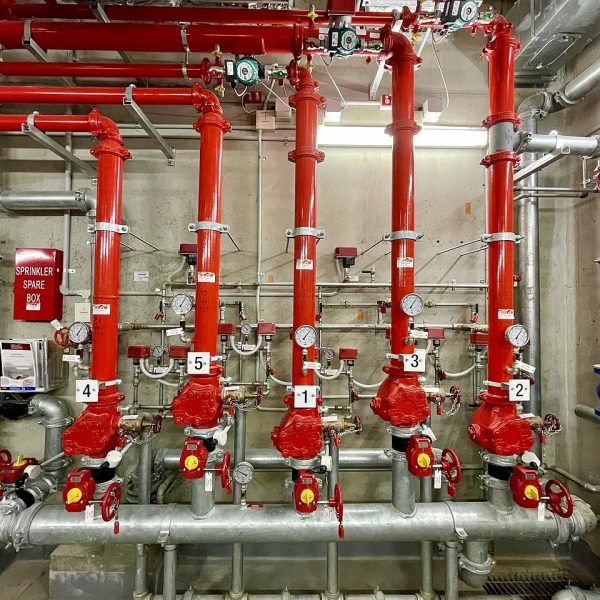
The Ontario Fire Code requires most commercial buildings to have a fire safety plan. Besides documenting your organization’s relevant supervisory contacts and evacuation procedures, your building’s fire safety plan must include the following information:
- Potential fire hazards
- Sources of ignition and their control
- Storage and handling procedures for hazardous materials
- Fire protection equipment necessary to control these hazards
Identifying these issues help you choose the proper sprinkler system for your building’s fire safety. Sprinkler systems are both a large financial investment and a crucial device for protecting both lives and property in the event of a fire.
You have four distinct types of sprinklers from which to choose. Hopefully, the following material can help you decide which is the best choice for your building.
Wet Pipe
Wet pipe sprinklers are the most common type. The sprinkler piping is always filled with water, and when the ceiling temperature reaches the designated temperature, a glass bulb or a fusible link at the sprinkler head breaks and releases water. However, despite what you may have seen in movies, water will only come out of the sprinkler head which was activated.
It’s the most reliable and cost-effective means of fire suppression and should be your first choice unless there’s a compelling reason to choose something else. If considering a wet pipe system, pay close attention to the temperature of the space you’re protecting. It must not drop below 4 degrees celsius, or you run the risk of the water freezing and bursting the pipes.
Dry Pipe
While quite similar to the wet pipe system, dry pipes are not filled with their water until the fire starts. When the ceiling gets hot enough to burst the glass bulb or fusible link, air will flow from the sprinkler head, which drops the pressure in the pipe. Water then enters the pipe and makes its way to the sprinkler head to extinguish the fire.
The delay in the arrival of the water limits the size of the area where you can safely use a dry pipe system. Its best application is for areas that can’t be reliably temperature-controlled. Nevertheless, the portion of the building where the valve is located must remain above 4 degrees celsius.
Preaction
Probably the most complicated sprinkler system, there are actually three different types of preaction systems from which to choose: Non-interlock, single interlock, and a double interlock. A preaction system is similar to a dry pipe system in that it doesn’t have water in the pipes prior to activation, but it’s distinctive in that it requires a specific event to activate the water release.
- Non-interlock sprinklers release water when prompted by detection devices or automatic sprinklers.
- Single interlock systems release water based on input from detection devices.
- Double interlock systems release water when both detection devices and the automatic sprinklers have been triggered.
Deluge
The final type of sprinkler system is the deluge. It’s similar to the preaction system in that it depends on independent detection devices to operate, and the water is not in the pipes until activation. However, the sprinkler heads themselves are open, so when the system activates, all of the sprinkler heads spray water.
When choosing your building’s sprinkler system, you need to consider what the system is protecting as well as the climate conditioning of the building. It’s not uncommon to have more than one type of sprinkler system protecting a single building when there are multiple uses.
If you’d like some expert help in developing a fire safety plan that incorporates the most important fire safety considerations, then consult the fire protection specialists at All Protect Systems, Inc. We’ve been serving Ontario area businesses since 1996, so call us today!